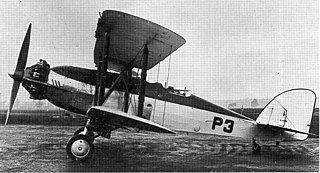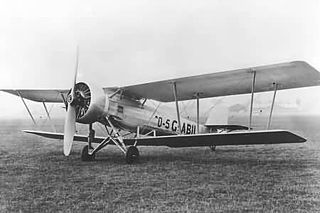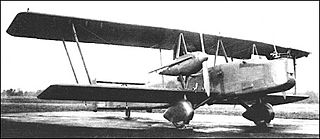
The Hawker Harrier was an experimental biplane torpedo bomber aircraft built by Hawker Aircraft to a specification issued in the 1920s for the RAF.

The Vickers Wellesley was a medium bomber that was designed and produced by the British aircraft manufacturer Vickers-Armstrongs at Brooklands near Weybridge, Surrey. It was one of two aircraft to be named after Arthur Wellesley, 1st Duke of Wellington, the other being the Vickers Wellington.

The Bristol Bombay was a British troop transport aircraft adaptable for use as a medium bomber flown by the Royal Air Force (RAF) during the Second World War.

The Hawker Hart is a British two-seater biplane light bomber aircraft that saw service with the Royal Air Force (RAF). It was designed during the 1920s by Sydney Camm and manufactured by Hawker Aircraft. The Hart was a prominent British aircraft in the inter-war period, but was obsolete and already side-lined for newer monoplane aircraft designs by the start of the Second World War, playing only minor roles in the conflict before being retired.

The Blackburn Shark was a British carrier-borne torpedo bomber built by the Blackburn Aircraft company in England. It first flew on 24 August 1933 and went into service with the Fleet Air Arm, Royal Canadian Air Force, Portuguese Navy, and the British Air Observers' School, but was already obsolescent by 1937 and in the following year, replacement by the Fairey Swordfish began.

The Vickers Type 131 Valiant was a British general-purpose biplane produced by Vickers in 1927, with the intention of replacing the Royal Air Force's Airco DH.9As, but was unsuccessful, with only a single example built, which was sold to Chile.

The Blackburn B-5 Baffin biplane torpedo bomber was a development of the Ripon, the chief change being that a 545 hp (406 kW) Bristol Pegasus I.MS radial replaced the Ripon's Napier Lion water-cooled inline engine.

The Hawker Hector was a British biplane army co-operation and liaison aircraft of the late 1930s; it served with the Royal Air Force and saw brief combat in the Battle of France in May 1940. Some Hectors were later sold to Ireland. It was named after the Trojan prince Hector.

The Hawker Horsley was a British single-engined biplane bomber of the 1920s. It was the last all-wooden aircraft built by Hawker Aircraft, and served as a medium day bomber and torpedo bomber with Britain's Royal Air Force between 1926 and 1935, as well as the navies of Greece and Denmark.

The Westland PV-3 was a British two-seat torpedo bomber of the 1930s built by Westland Aircraft Works. The aircraft was a private venture development and based on the Westland Wapiti. It never entered production. The aircraft is best known as one of the first two to fly over Everest as part of the Houston-Mount Everest Flight Expedition.

The Armstrong Whitworth Atlas was a British single-engine biplane designed and built by Armstrong Whitworth Aircraft. It served as an army co-operation aircraft for the Royal Air Force (RAF) in the 1920s and 1930s. It was the first purpose-designed aircraft of the army co-operation type to serve with the RAF.

The Avro 604 Antelope was a British light bomber which was designed and built in the late 1920s to meet a requirement for a light bomber to equip the Royal Air Force, competing against the Hawker Hart and the Fairey Fox II. It was unsuccessful, the Hart being preferred.

The Vickers Vespa was a British army cooperation biplane designed and built by Vickers Limited in the 1920s. While not adopted by Britain's Royal Air Force, small numbers were bought by the Irish Free State and Bolivia, the latter of which used the type during the Chaco War. One modified Vespa was used to set a world altitude record of 43,976 ft (13,407 m) in September 1932.

The Vickers Vanox was a British biplane bomber design intended as a successor to the Virginia for the Royal Air Force. Although it underwent extensive development, it was not successful, only a single aircraft being built.

The Handley Page HP.34 Hare was a British two-seat high-altitude day bomber designed and built at Cricklewood by Handley Page. It was designed by Harold Boultbee to meet the requirements of Air Ministry Specification 23/25 for a replacement for the Hawker Horsley in the day bomber role, competing against the Blackburn Beagle, Hawker Harrier, Gloster Goring and Westland Witch. The Hare was a conventional biplane, with single-bay unequal-span staggered wings, of mixed wood and metal construction. It had a crew of two with the pilot in an open cockpit aft of the wing with a gunner/bomb aimer behind him.

The Parnall G.4/31 was a 1930s design from the George Parnall and Company to meet Air Ministry Specification G.4/31 for a "general purpose" aircraft.

The Armstrong Whitworth A.W.19 was a two/three-seat single-engine biplane, built as a general-purpose military aircraft in the mid-1930s. A newer, monoplane aircraft was preferred and only one A.W.19 was built.

The de Havilland DH.56 Hyena was a prototype British army cooperation aircraft of the 1920s. A single-engined biplane, the Hyena was designed against an RAF requirement, but was unsuccessful with only two being built, the Armstrong Whitworth Atlas being preferred.

The Vickers Type 253 was a single-engined two-seat biplane general-purpose military machine built to a 1930 government specification. It won a production contract, but this was transferred to the same company's monoplane equivalent, the Wellesley. Only one Type 253 was built.
The Westland PV.7 was a private venture submission to a 1930s British specification for a general-purpose military aircraft with two crew. It was a single-engined, high-wing monoplane of promise, but was destroyed early in official tests.



















